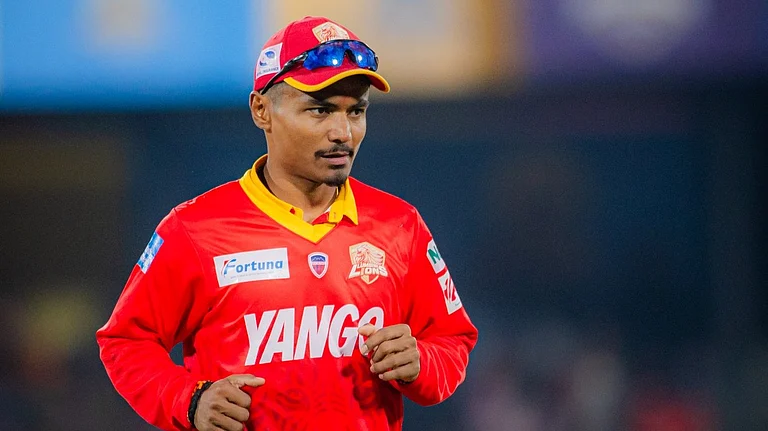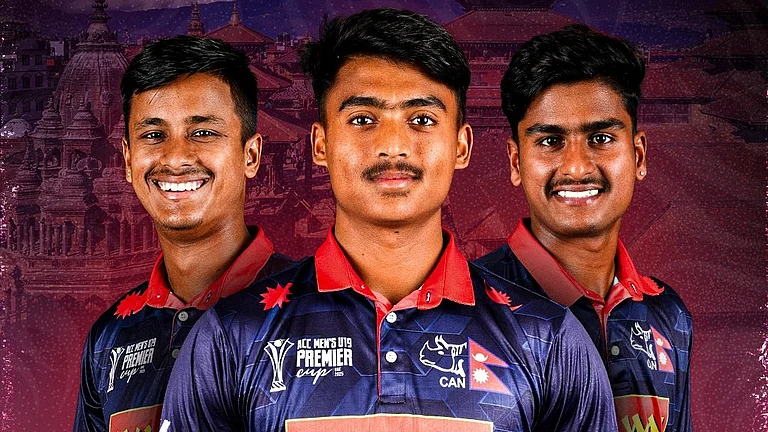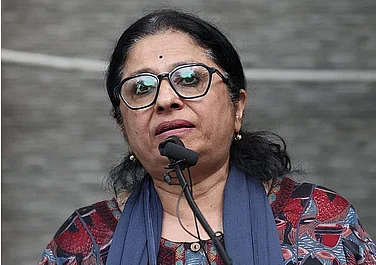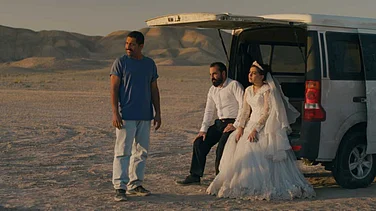Twenty-seven minutes into 3 Idiots (2009), the voiceover takes a break from deifying Rancho (Aamir Khan) and introduces a college student, Joy Lobo (Ali Fazal), as “someone just like him”. Close to building an inventive helicopter, Lobo requests the college dean, Virus (Boman Irani), for an extension. Virus denies it, calling his project nonsense. Six minutes (and two songs) later, Rancho makes the helicopter work. As it flies and settles outside Lobo’s room window, its camera records his body hanging from the ceiling. Two words wail from the wall: “I quit.”
Rancho calls it a “murder”, implying Virus, representing the educational “system”, is responsible. He cites figures—a student dies by suicide every 90 minutes in the country. (That number has nosedived to 41, according to a 2021 report by the National Crime Records Bureau.) Even before 3 Idiots, another Bollywood film, Chal Chalein (2009), had a similar scene where, fearing his father’s rebuke, a student kills himself. Here, his friends literally accuse the father of murder, suing him with the help of a lawyer (Mithun Chakraborty).
Much like our society, Hindi cinema has shied away from challenging people upholding tradition, such as parents or teachers. Suicides allowed these stories to open a channel of long-shut inquiry, as it’s inconceivable to think of those as villains who have always been considered heroes. Or, quite simply, it eased the filmmakers into asking a disconcerting question: What kind of a society gets away with murdering its own children?
These two films also stand out for their portrayals of suicides. Because, before 2009, scenes of self-harm in Bollywood largely appeared in two contexts: romantic failure (Ek Duuje Ke Liye, Qayamat Se Qayamat Tak, Mohabbatein) or threat to sexual honour (Khilona, Muqaddar Ka Sikandar, Ghar). The latter signifies sexual ‘purity’—an idea as old as Sita’s death in the Ramayana. Even though such reasons have continued to justify on-screen suicides, some Bollywood filmmakers, over the last decade, have also used them as a technique of mediation, stretching to shake an authority even bigger than parental figures: the state itself.

Peepli Live (2010), a satirical drama, hinges on the ‘anticipation’ of suicide. Reeling under heavy loans, Natha (Omkar Das Manikpuri), a farmer, wants to kill himself, hoping the government compensation would end his family’s troubles. This suicide doesn’t intend to stop but start a story. It’s a way to talk to someone so distant that no other method would work. This is suicide as negotiation—as plea. It’s also a last-ditch attempt to make the ‘little man’ not so little, to make the invisible visible. Its more literal version appears in Main Azaad Hoon (1989)—where an “aam Hindustani” (Amitabh Bachchan), protesting the system’s failure, threatens to kill himself—presenting suicide as a last lunge that interrupts the status quo.
Death carries symbolic meanings in cinema. It can be used as a screenwriting device to smoothen out uncomfortable crossroads. The death of Jai (Amitabh Bachchan) in Sholay (1975), for example, enabled its writers, Salim-Javed, to resolve the thorny possibility of his marriage to a widow (Jaya Bachchan). Suicide broadens that canvas, allowing filmmakers to hide in plain sight. “The socio-centric self involves others,” writes psychiatrist Dinesh Bhugra in his book Mad Tales from Bollywood (2006), “so the act of deliberate self-harm is also meant to hurt others.” This helps contextualise the two suicides in 404: Error Not Found (2011). Ragging causes the first and a professor’s betrayal the second. Both the college management and professor represent revered, authoritative figures—just like parents—whose final word is the only word, leaving their victims in suffocating silos. So how do you make, to quote Bhagat Singh, “the deaf hear”? Well, through a “loud sound”. Suicide is that bomb, doubling up as a shield and a sword.
You can, in fact, draw a clear through line between the deceased characters’ psychologies in Chal Chalein and 404 where, despite their anguish, they never confront their tormentors, a father and a professor. “Suicide is a symptom, and every symptom is a communication,” says Eeshani Chakraverty, a Mumbai-based psychotherapist. “A person dying by suicide is a failed communication or a plea for help that has not been recognised.”

In the 2019 coming-of-age drama Chhichhore, that metaphor becomes literal, where a father (Sushant Singh Rajput) urges his son, who lies unconscious on a hospital bed, to speak—to talk. Unlike most Bollywood films, Chhichhore features a liberal father—the kind who says “saala” and “yaar” to his son, ribs him, tells him to not worry about academics—but despite such assurances, on failing the joint entrance exam, the boy is so guilt-ridden about facing his parents that he tries to kill himself. The movie upends the familial power dynamics in Hindi cinema, as a father confesses to his son that he was once a “loser”—telling him an uplifting story about his college days—dispelling shame through conversation.
Other depictions of suicide have broadened that definition, foregrounding an emotional vacuum ignored in Hindi cinema for long: crumbling mental health. Both Karthik Calling Karthik and The Dirty Picture—released in 2010 and 2011, when conversations about therapy were not as pronounced as they are today—contributed to a nuanced understanding of depression. Departing from convention, they featured famous actors, such as Vidya Balan and Farhan Akhtar, playing protagonists hurtling towards self-harm. By doing so, they normalised depression—that it could affect anyone—liberating it from the disparaging definition of ‘madness’.
“When you pick big stars to talk about grave issues,” adds Chakraverty, “the filmmaker takes a lot of responsibility to attract an audience and that is commendable. Sometimes excellent messages get lost simply because they haven’t been made with the A-list stars.”
Besides, by linking mental health to death—which, in Indian movies and society, is almost always laced with gravitas—these movies gave depression its long-denied dignity and its “victims” much-needed empathy. An even better example is Gehraiyaan (2022) which, through Alisha’s (Deepika Padukone) mother’s suicide, not only captures the despair of mental health malaise but also shows how children inherit the (psychological) scars of their parents, wearing anxiety like a cloak, replicating their self-harm patterns.
“Our earlier generational traumas—which can go as far back as colonialism—make us susceptible to a crisis,” says Chakraverty. “And they make us take decisions that are almost self-sabotaging. I thought Gehraiyaan showed the angst of Deepika very nicely. It, at first, feels quite unexplainable but when they show the intergenerational trauma, it hits you as an ‘aha’ moment.”
But the older implications of suicide—tied to romantic failure or sexual honour—have continued to persist in Hindi cinema. Another Padukone starrer, Padmaavat (2018), is its most striking example, where Rajput women, ‘resisting’ the invading army of Alauddin Khilji, perform jauhar to save their honour. Everything about this scene is off-putting—its needless theatrics, its ludicrous glorification, its repulsive politics—unfolding as a master class on how to not film suicides. Other portrayals range from flippant (Anjaana Anjaani) to contrived (Rakshabandhan) to exploitative (Kaabil). Such depictions, of course, recur in non-Hindi movies as well, especially in the ’80s and the ’90s Tamil cinema. The suicide in Rajinikanth-starrer Enthiran (2010) shows its hold even in the subsequent decades.
But a 1992 Tamil drama presents a rare case of a director in conversation with himself. Upset by numerous suicides inspired by his own Ek Duuje Ke Liye, K Balachander made Vaaname Ellai (1992) about five distraught friends who, wanting to kill themselves after 100 days, eventually change their minds. The critically acclaimed Marathi movie Gabhricha Paus (2009), centred on farmers in Vidarbha, weaved in suicides to blend narrative propulsion and political commentary. Malayalam cinema, too, has memorable examples aplenty. Both at the level of plot (the protagonist in the 2004 film Kadhavaseshan kills himself because the cruel society suffocates him with shame) and at the level of form (in G Aravindan’s Chidambaram released in 1985, an abrupt long shot of a body hanging from the roof of a cowshed captures the silent aftermath of shame in chilling detail).
Even though a few impressive portrayals have popped up in Hindi cinema over the last decade, Bollywood hasn’t quite probed the deeper, more fundamental meaning of suicide. This lack seems all the more perplexing because its dominant storytelling nature itself aids such contemplations. Bollywood, as professor Lalitha Gopalan points out in her book, is the “Cinema of Interruptions” (2002). It’s characterised by songs, flashbacks, inter-textual references—even intervals—constantly alerting the audiences about the artifice of the enterprise, reminding them often, as opposed to classic Hollywood’s emphasis on continuity editing, that they’re watching a fictional piece. The literary equivalent of a Bollywood film, then, could be a postmodernist novel, replete with flowing endnotes, footnotes, meta references (and numerous parenthetical asides (and parenthetical asides within parenthetical asides)).
So it isn’t too surprising that a postmodernist master, David Foster Wallace (who killed himself at the age of 46), gave the most succinct and precise description of suicide—the ultimate interruption. Likening it to “jump[ing] from the window of a burning high-rise”, he said the “fear of falling remains a constant”. But when “the flames get close enough, falling to death becomes the slightly less terrible of two terrors.” It’s this line of thought that deserves more attention in Bollywood films because, given their vast appeal, they’ll help our society understand the crux of suicide: that it isn’t cowardice; it’s self-preservation.
(This appeared in the print as 'Bollywood's Tryst With Suicides')


























